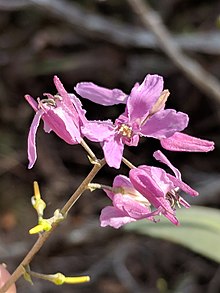
Streptanthus glandulosus subsp. niger is an endangered subspecies of flowering plant within the family Brassicaceae. Like other genus members, this herb has wavy petal margins with perimeter calluses that discourage larval herbivory. This plant is endemic to the Tiburon Peninsula of Northern California, and occurs at elevations below 150 m on serpentine grasslands. The common name for this subspecies is Tiburon jewelflower or black jewelflower. This annual herb blooms in May and June and displays dark purple sepals. The etymology of this genus scientific name derives from the Greek word streptanthus, meaning twisted flower, with reference to the notable wavy margins of the petals. The subspecies name niger relates to the color of the seeds being black, although an alternate account cites the dark color of the petals as the source of the appellation.
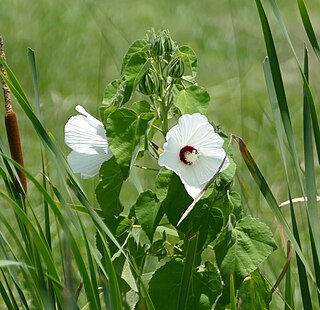
Hibiscus lasiocarpos is a species of hibiscus known by the common names hairy-fruited hibiscus and wooly rose-mallow. It is also one of several hibiscus called rosemallow. It is native to much of the southeastern United States, as well as parts of California and northern Mexico. It is a large, bushy perennial herb with sprawling stems reaching one to two meters long. The leaves are heart-shaped, toothed, and pointed, and generally between 6 and 10 centimeters long. The inflorescence holds large showy, solitary flowers. Each flower has a cup of partly fused sepals beneath a layer of slender bracts. These may be covered in hairs or woolly fibers. The flower's large petals may be up to 10 centimeters long and are generally bright white with red bases. The stamen tube and anthers are white or cream. The fruit is a capsule 2.5–3 centimeters long containing spherical seeds.
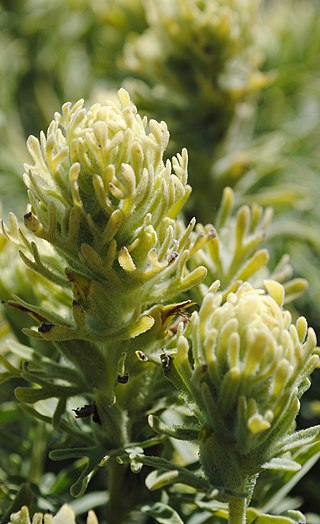
Castilleja grisea is a rare species of Indian paintbrush known by the common name San Clemente Island Indian paintbrush. It is endemic to San Clemente Island, one of the Channel Islands of California. San Clemente Island is owned by the US Navy so the Navy is involved in a management program to recover this species.
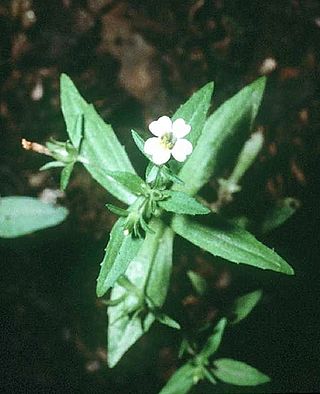
Gratiola neglecta is a species of flowering plant known by the common name clammy hedgehyssop. It is native to much of North America, including most all of the United States and the southern half of Canada. It is generally found in moist to wet habitat. This is an unobtrusive annual herb producing a glandular stem up to about 30 centimeters tall. The lance-shaped to oval leaves are arranged oppositely about the stem. They are up to 5 centimeters long and sometimes toothed along the edges. The inflorescence is a raceme of nearly cylindrical tubular whitish flowers each about a centimeter long. At the base of each flower is a fringe of five pointed sepals. The fruit is a spherical capsule about half a centimeter wide.
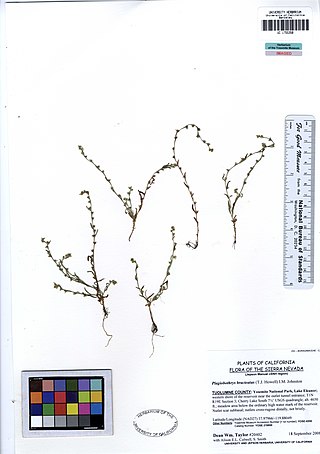
Plagiobothrys bracteatus is a species of flowering plant in the borage family known by the common name bracted popcornflower.

Streptanthus longirostris is a species of flowering plant in the family Brassicaceae, which is known by the common name longbeak streptanthella, or simply streptanthella. It is native to western North America, where it occurs throughout the western United States and the northwestern states of Mexico. It grows in many types of habitat, including deserts, sagebrush, foothill woodlands, sandy flats, chaparral, and scrubby canyons.

Streptanthus glandulosus subsp. albidus is a subspecies of flowering plant in the mustard family known by the common name Metcalf Canyon jewelflower. It is endemic to California, where it is known only from the Central Coast Ranges in the San Francisco Bay Area. It grows in open areas such as grasslands, often on serpentine soils.
Streptanthus barbiger is a species of flowering plant in the mustard family known by the common name bearded jewelflower. It is endemic to California, where it is limited to the North Coast Ranges. It grows in woodlands and chaparral habitat, often on serpentine soils. It is an annual herb producing a branching stem up to about 80 centimeters in maximum height. Leaves near the base of the stem are lance-shaped to oval and pointed, usually with toothed edges, the blades measuring up to 7 centimeters long. Leaves higher on the stem may be longer but are narrower and have smooth edges. Flowers occur at intervals along the upper stem. Each has a spherical to urn-shaped calyx of greenish yellow or purple sepals under a centimeter long. Whitish or purple-tinged petals up to a centimeter long emerge from the tip. The fruit is a long, flat, curving silique which may be 7 centimeters in length.
Streptanthus batrachopus is a rare species of flowering plant in the mustard family known by the common name Mt. Tamalpais jewelflower. It is endemic to Marin County, California, where it is known only from Mt. Tamalpais and surrounding terrain. There are fewer than ten known occurrences.
Streptanthus brachiatus is a species of flowering plant in the mustard family known by the common name Socrates Mine jewelflower. It is endemic to the Inner North Coast Ranges of California north of the San Francisco Bay Area. It can be found in chaparral and woodland habitat, often on serpentine soils, in Sonoma, Lake, and Napa Counties. It is a biennial herb producing a branching stem up to about 60 centimeters in maximum height. There is a basal rosette of fleshy purple-green leaves around the base, each with a sharp-toothed, widely lance-shaped blade up to 4 centimeters long. Leaves higher on the stem vary in shape. Flowers occur at intervals along the upper stem. Each has an urn-shaped calyx of keeled yellowish or purplish sepals just under a centimeter long. White, purple, or purple-veined white petals emerge from the tip. The fruit is a thin, narrow silique which may be up to 6 centimeters in length.
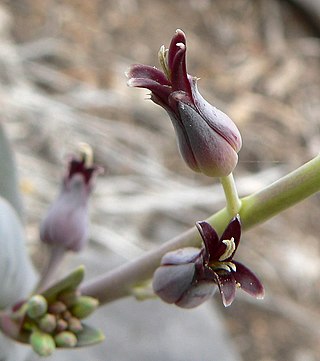
Streptanthus cordatus is a species of flowering plant in the mustard family known by the common name heartleaf twistflower. It is native to the western United States, where it can be found in many types of sagebrush, woodland, and forest habitat. It is a perennial herb producing a branched or unbranched stem up to about a meter tall. It is often waxy in texture. The basal leaves are oval or spoon-shaped with bristle-toothed blades borne on rough-haired petioles. Leaves higher on the stem are oval to lance-shaped, up to 9 centimeters long with their bases usually clasping the stem. Flowers occur at intervals along the upper stem. Each has a calyx of sepals roughly a centimeter long which begin greenish yellow and mature purple. Four purple petals emerge from the tip of each calyx. The fruit is a thin, narrow silique which may reach 14 centimeters in length or longer.

Streptanthus diversifolius is a species of flowering plant in the mustard family known by the common name variableleaf jewelflower, or varied-leaved jewelflower. It is endemic to California, where it is limited to the Sierra Nevada foothills. It is a resident of woodlands and other foothill habitat. It is an annual herb producing a hairless, waxy stem up to a meter tall. The basal leaves are variable in shape and are often divided into narrow, threadlike segments. Leaves higher on the stem are also variable, having round to lance-shaped blades which clasp the stem at their bases. Flowers occur at intervals along the upper stem, with one or two leaflike bracts at the base of the raceme. Each flower has an urn-shaped calyx of keeled sepals about half a centimeter long and white, yellowish, or purple in color, sometimes with white edging. White, purple-veined petals emerge from the tip. The fruit is a thin, flat, curving silique which may be 8 or 9 centimeters in length.
Streptanthus farnsworthianus is an uncommon species of flowering plant in the mustard family known by the common name Farnsworth's jewelflower. It is endemic to California, where it is limited to the woodlands of the Sierra Nevada foothills. It is an annual herb producing a hairless, waxy, purple or purple-tinged stem up to half a meter tall or more. The ephemeral basal leaves have blades up to 15 centimeters long which are each divided into several narrow lobes or leaflets. Leaves higher on the stem have purple lance-shaped blades that generally clasp the stem at their bases. Flowers occur at intervals along the upper stem with one or two leaflike purple bracts at the base of the raceme. Each flower has an urn-shaped calyx of purple sepals up to a centimeter long. Curling purple-veined white petals emerge from the tip of the calyx. The fruit is a straight or curving silique up to 12 centimeters long.
Streptanthus fenestratus is an uncommon species of flowering plant in the mustard family known by the common name Tehipite Valley jewelflower.
Streptanthus gracilis is an uncommon species of flowering plant in the mustard family known by the common name alpine jewelflower.
Streptanthus howellii is an uncommon species of flowering plant in the mustard family known by the common name Howell's jewelflower.

Streptanthus tortuosus is a biennial or short lived perennial plant in the mustard family (Brassicaceae) known by the common names shieldplant, shieldleaf, and mountain jewelflower.

Borodinia serotina is a rare species of flowering plant in the mustard family known by the common name shale barren rockcress. It is native to eastern West Virginia and western Virginia in and around the Shenandoah Valley, where it is known from 62 populations. It is endemic to the shale barrens, a type of habitat characterized by steep slopes of bare shale, an exposed, rocky habitat type that is subject to very dry and hot conditions. Shale barrens host a number of endemics, such as Allium oxyphilum and Taenidia montana, and this rockcress is among the rarest. It is a federally listed endangered species.

Silene polypetala is a rare species of flowering plant in the family Caryophyllaceae known by the common names eastern fringed catchfly and fringed campion. It is native to Georgia and northern Florida in the United States. It is threatened by the loss and degradation of suitable habitat. It is a federally listed endangered species of the United States.

Leavenworthia crassa is a species of flowering plant in the mustard family, Brassicaceae, known commonly as the fleshy-fruit gladecress. It is endemic to Alabama in the United States, where it occurs in only two counties. It is "likely one of the most imperiled plant species in the Southeast," and the United States Fish and Wildlife Service issued a final rule listing it as an endangered species in 2014.
